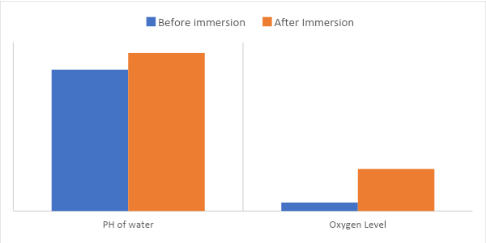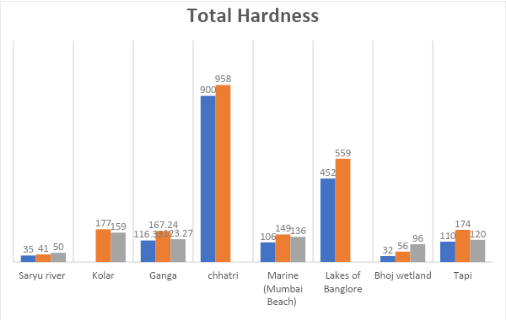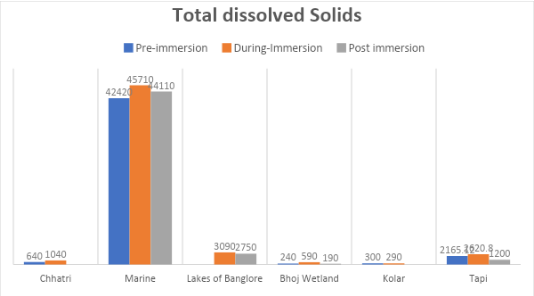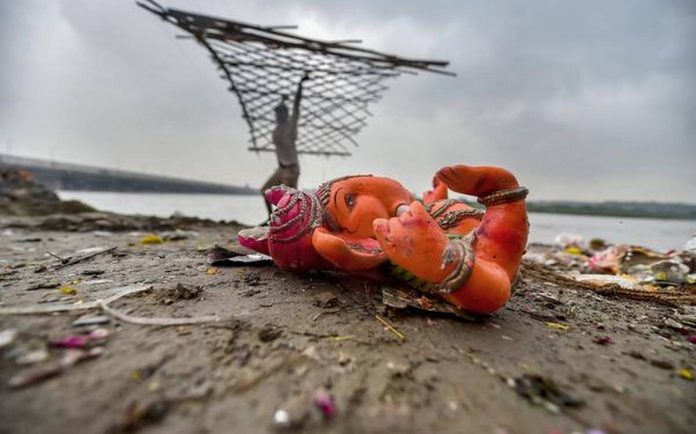This article has been written by Avni Singhania.
Table of Contents
Introduction
“Ganpati Bappa, Morya”. These words spring joy in every Mumbaikar. Mumbai can be associated with many things, but I associate it with the Ganpati Festival. It is a festival of joy and togetherness which is celebrated in mid-August/September. As a child, I would go visit pandals. Each year the pandal would get bigger and more grandeur. This beauty would become a horrid sight on the day of immersion. The day Ganpati is brought, the entire city is celebrating and when it leaves, the entire city is mourning. Not because the festival has come to an end but because of the broken pieces on the shore that comes the next day. It is really heartbreaking to see the God we worship, be shattered like this. Moreover, the harm it does to the environment is known by all.
The aftermath of immersion
The Bhagavad Gita (Chapter 9 verse 26) states: “Patram Pushpam phalam toyam, yo mey bhaktya prayachchati Tadaham bhakt yupahrutam asnaami prayataatmanaha” which literally means, whoever offers Me (God) with devotion; a leaf, a flower, a fruit or water, I accept that as the pious offering of the pure heart.
I quoted the Bhagavad Gita to explain that what we do that day is not what God wanted. The Bhagavad Gita asks us to celebrate an environmentally friendly festival. However, we have converted it into a competition of pandals, aiming to make one more grandeur than the other. Traditionally, the idols were made with clay and coloured with natural colours like turmeric and worshipped with natural things like coconut, curd, milk and water. However, today they are made of plaster of Paris (“PoP”), clay, cloths, small iron rods, bamboo and decorated with different paints such as varnish, watercolours, etc. This increased the level of pollution in water bodies. There are several studies that show the impact of idol immersion on water bodies. I will be discussing a few in this article.
Data
The Central Pollution Control Board (“CPCB”) did a study on the impact of immersion of Ganesh Idols on lakes. They concluded that the water quality had depleted, the acid content had increased, the TDS (Total Dissolved Solids) had increased by 100% and the oxygen level had reduced. Even heavy metals like iron and copper had increased by 10 times in the composition of the water.
In 2014, another study was conducted on the lakes of Mumbai. The study concluded that there were significant changes in the physicochemical properties of water. The PH of water before immersion was 6.7-6.8, but after immersion, it was 7.5. The temperature of the lakes also increased. This affected the oxygen level in the water. During pre-immersion, the dissolved oxygen was observed to be very low (0.4-0.5mg/litre). It was observed comparably high during the post-immersion (1.4-2.5 mg/litre) which is not suitable for fauna and flora.

Another study analysed water bodies all over India. The study discussed the impact on water bodies for the pre-immersion period, during immersion and post immersion. For all the water bodies around the country, the study concluded that it adversely affected the water composition. I have made a table below to understand the impact of water pollution on the various water bodies.


Another study by The Department of Marine Science on the Hooghly River in 2018, also concluded that idol immersion has an adverse impact on water bodies. The PH value changed, it was alkaline during pre-immersion and it became acidic post-immersion due to the synthetic material immersed in the river. An abrupt increase in turbidity was also seen due to the huge biomass of leaves and flowers, unused material and different inorganic substances. An adverse impact on phytoplankton was also seen. It affected both the qualitative and quantitative characteristics of phytoplankton.
It is evident that idol immersion does pollute the water bodies drastically, so why isn’t something being done about it?
The role of Judiciary
In 2003, a PIL was filed in the Bombay High Court in the case of Janhit Manch & Ors vs. the State of Maharashtra & Ors. The matter was decided by the court in 2008. The petition was filed to bring several reliefs so that water pollution can be contained in the state of Maharashtra. One of the reliefs was the ban on the practice of idol immersion. The petitioner contended that in Mumbai alone 1,50,000 idols are immersed and the idols are made of PoP mixed with other ingredients which can be poisonous and fatal to marine life. The court agreed to the arguments of the petitioner and directed the Central Government to come up with guidelines for the immersion of idols to contain pollution. The court further directed that the Union Government and the State Government should consider these guidelines and act expeditiously.
As per the directions of this case, CPCB introduced guidelines for both idol immersion and other puja material. They gave guidelines for idol immersion to local bodies/authorities with regards to immersions in lakes, rivers and in the sea. The general guidelines for idol immersions were that idols should be made from traditional clay rather than backed clay or PoP. Idols should only be painted with water-soluble and nontoxic natural dyes and any other toxic chemical should be strictly prohibited. Worship material should also be removed before immersion of idols. Local authorities should identify adequate spots and make artificial lakes for immersion. Synthetic liners should be placed at the bottom of these water bodies. The left-over material on the shore of the water body should be collected and disposed of within 48 hours of immersion.
In 2009, the CPCB came up with more guidelines and the chairman of the CPCB visited Kolkata to assess the ghats of idol immersion and to speak to craftsmen. Along with the West Bengal State Pollution Board (WBSPCB), they did awareness camps so that craftsmen use biodegradable materials. The SPCB and the PCC were asked to conduct a water quality assessment of the water body at the three stages i.e. pre-immersion, during immersion and post immersion. People were also encouraged to go for smaller size idols.
Critical analysis
According to me, the guidelines are well-drafted and can reduce pollution considerably. However, even today there is not much change in the way we perform idol immersion. The question remains why? The reason being that till date there has been no action taken by the state government to implement the guidelines. The recent order, in this case, is in 2018. The Bombay High court addresses that even after 10 years (22nd July 2008 – 29th June 2018) there is no action taken by the state government, and instead of strict penalty for non-compliance, the court gave the petitioner i.e. chief secretary of the state an opportunity to be heard who has still not heard after two years.
Sureshbhai Keshavbhai Waghvankar and others v State of Gujarat and ors
In 2012, there was another case filed in the Gujarat High Court (Sureshbhai Keshavbhai Waghvankar and others v State of Gujarat and ors). This case was filed by a group of idol manufactures and artisans they contended that guidelines by the CPCB and Principle Secretary of the Forest and Environment Department Gandhinagar were unconstitutional as it goes against Article 304 i.e. instances where trade can be restricted.
Their argument was that PoP has been used by them for years to make idols of gods and goddesses. Further other states like the State of Maharashtra have still not banned it. They also presented a scientific study by SERI which stated that PoP is not poisonous and does not cause any serious effect on water bodies. The applicants stated that making idols of clay is impractical as it is heavier, requires more manual work and difficult to transport.
Their job is merely to make and sell and it’s the government’s responsibility to ensure immersion is done properly. The court firstly held it illegal and uplifted the ban. Under Section 5 of the Environment (Protection) Act, 1986, the State Government had no power to make such laws. Secondly, the court discusses that the respondent’s (CPCB) argument to invoke the “Precautionary Principle” is not valid as PoP was not found to be an environmental pollutant due to scientific uncertainty.
However, the court agreed that the use of PoP is harmful and directed SPCBs and GPCB to come with certain directions to prevent water pollution. It also directed the GPCB and other boards to conduct a scientific study and come up with guidelines in 3 months.
Criticism
According to me, this judgement can be highly criticised especially the way the precautionary principle was applied. The court said, “had there been scientific studies and tangible material to infer that PoP is harmful to health or causes water pollution and if the notification in question was under the Water Act, the legal effect of such ban might have been viewed differently.”
This is rather an incorrect application of the precautionary principle. The purpose of the precautionary principle was to counter the traditional presumption that activities should proceed unless they are proven to be harmful. It recognises that delaying action can lead to a great threat. At many conferences, it has been clarified that when an activity can raise harm to human health, the precautionary principle should be applied and measures should be taken even when there is a lack of scientific certainty.
The various guidelines set by the CPCB and other boards can be considered as precautions taken to prevent pollution. Thus, they should be applied irrespective of scientific certainty. Many times, science is not right and there can be scientific uncertainty. The absence of proof doesn’t mean the absence of harm. Moreover, the court did agree that it was extremely harmful but still did not apply the principle. Even the case cited by the judge said that it is harmful and should be acted upon expediently. This could be a landmark judgment but because the court gave too much importance to scientific certainty, there is no strict application of the CPCB guidelines by the State Government. I also believe when guidelines do not invoke the precautionary principle, they are not complied with as there is no penalty for it, which should be imposed by our courts.
Rajesh Madhukar Pandit and Ors v. The Nashik Municipal Corporation
Finally, Rajesh Madhukar Pandit and Ors v. The Nashik Municipal Corporation clarified the position on the precautionary principle and declared it as the law of the land. This case did not primarily discuss idol immersion. The court stated the precautionary principle is a part of environmental law under Article 21 which guarantees protection of life and personal liberty. It is also mandatory under Article 47, 48-A and 51-A(g) which mandates protection and improvement of the environment.
Apart from the Constitution, there are other legislations that discuss environmental protection. As a part of the precautionary principle, the court directed the Nashik Municipal Corporation to make artificial/temporary ponds near the river for immersion of Ganapati and other idols.
Even after this decision, in 2019 July, there was a case before the Bombay High Court (Worli Koliwada Nakhwa v. Municipal Corporation of Greater Mumbai), where aquatic life near the coast of Bombay was endangered due to the construction of the coastal line. In this case, the scientific evidence given stated that there was going to be no harm. However, as the judge was an environmentalist himself, he took it on himself to prove the scientific study wrong and gave an injunction on the order. Thus, I think it’s time legislation steps in to establish a clear position on scientific uncertainty and the precautionary principle.
Conclusion
While COVID-19 has wreaked havoc and ruined the lives of many, its effect on water pollution can be said to be a silver lining. This year for the Ganpati immersion, the BMC had 170 artificial ponds in every ward of Mumbai and made special arrangement i.e. Mobile Immersion Spots on Wheels for immersion due to the virus.
Moreover, idols were only allowed to be 4ft. All idols were made of water-soluble clay and were immersed in artificial ponds rather than the Arabian sea. More than 50% were immersed in artificial ponds. An NGO worker who cleans the beaches after the immersions said that it was 60% cleaner than any other year. Many people saw how clean the environment was and I believe this could encourage them to act more responsibly.
Thus according to me, the mobile immersion spots and artificial ponds in each ward should be made a ‘new normal’ for immersion. Moreover, in the future, the Judiciary should come up with mandated guidelines for idol immersion like they did with the Vishaka guidelines for workplace safety. Currently, The Water Act, 1974 mainly penalises industries for polluting water bodies. An amendment should be made in the Act to punish individuals as well will make individuals more conscious and encourage them to celebrate festivals in a more environmentally friendly manner.
References
- Swami Mukundanandaa, Bhagavad Gita (Oct 1,2020, 12:08 PM) https://www.holy-bhagavad-gita.org/chapter/9/verse/26).
- Central Pollution Control Board (Ministry of Environment and Forests), Guidelines for Idol Immersion, Government of India 4 (2010).
- G. Thirumurthy (Environmental Engineer, Central Pollution Control Board), General Guidelines Idol Immersion, Central Pollution Control Board 4 (2008).
- Sachin Bhagat & Anju Singh, Environmental Impact of Ganpati Idol Immersion on Water Quality of Two Lakes in Mumbai, International Journal of Scientific Research, 1 (2014).
- Sayan Bhattacharya et al., Effects of idol immersion on the water quality parameters of Indian water bodies: Environmental health perspectives, International Letters of Chemistry, Physics and Astronomy. (2014). The waterbodies were: “Bhoj wetland, Budhabalanga river, Ganges river, Hussainsagar lake, Kolar river, Sarayu river, Tapi river, Chhatri lake, north and west lakes of Bangalore and Yamuna river”.
- Dibyendu Rakshit & Santosh Kumar Sarkar, Idol Immersion and its adverse impact on water quality and plankton community in Hooghly (Ganges) River, Estuary, India: Implications for conservation management. Indian Journal of Geo Marine Sciences 1872 (2018).
- Janhit Manch & Ors vs. the State of Maharashtra & Ors. (2003) WP (C) No. 1325 of 2003 (India).
- Central Pollution Control Board (Ministry of Environment and Forests), Guidelines for Idol Immersion, 4 (2010).
- Dibyendu Rakshit & Santosh Kumar Sarkar, Idol Immersion and its adverse impact on water quality and plankton community in Hooghly (Ganges) River, Estuary, India: Implications for conservation management. Indian Journal of Geo Marine Sciences 1872 (2018).
- Central Pollution Control Board (Ministry of Environment and Forests), Guidelines for Idol Immersion, 4 (2010).
- Sureshbhai Keshavbhai Waghvankar and others v State of Gujrat and ors, (2013) N.T.G. 65/2012. (India).
- Aaron Holdway, Reducing Uncertainty: The Need to Clarify the Key Elements of the Precautionary Principle, Columbia University 47 (2008).
- Nancy Myers, Debating the Precautionary Principle, Science and Environmental Health Network, 2020 https://www.sehn.org/sehn/2020/1/16/debating-the-precautionary-principle
- Anne Ingebord Myhr & Terje Traavik, The Precautionary Principle: Scientific Uncertainty and Omitted Research in the Context of GMO Use and Release, Journal of Agricultural and Environmental Ethics, 76 (2002).
- Rajesh Madhukar Pandit and Ors v The Nasik Municipal Corporation, (2018) PIL 176/2012 (India).
- Worli Koliwada Nakhwa v Municipal Corporation of Greater Mumbai, (2019) WP 560/2019 (India).
- Sparshita Saxena, BMC advises home immersion for Ganesh idols in Mumbai, bans gatherings, Hindustan Times, ( September 20, 2020, 10:18 AM) https://www.hindustantimes.com/india-news/bmc-advises-home-immersion-for-ganesh-idols-in-mumbai-bans-gatherings/story-IZ5dtV5mQ6M2ahjgVpaJoI.html.
- Ganeshotsav 2020: Artificial ponds boost eco-friendly immersions in Mumbai, few idols head to sea, Times of India (September 20, 2020, 10:18 AM) https://timesofindia.indiatimes.com/city/mumbai/covid-19-quiet-immersion-of-ganesh-idols-in-mumbai/articleshow/77708367.cms
LawSikho has created a telegram group for exchanging legal knowledge, referrals and various opportunities. You can click on this link and join:
 Serato DJ Crack 2025Serato DJ PRO Crack
Serato DJ Crack 2025Serato DJ PRO Crack











 Allow notifications
Allow notifications



